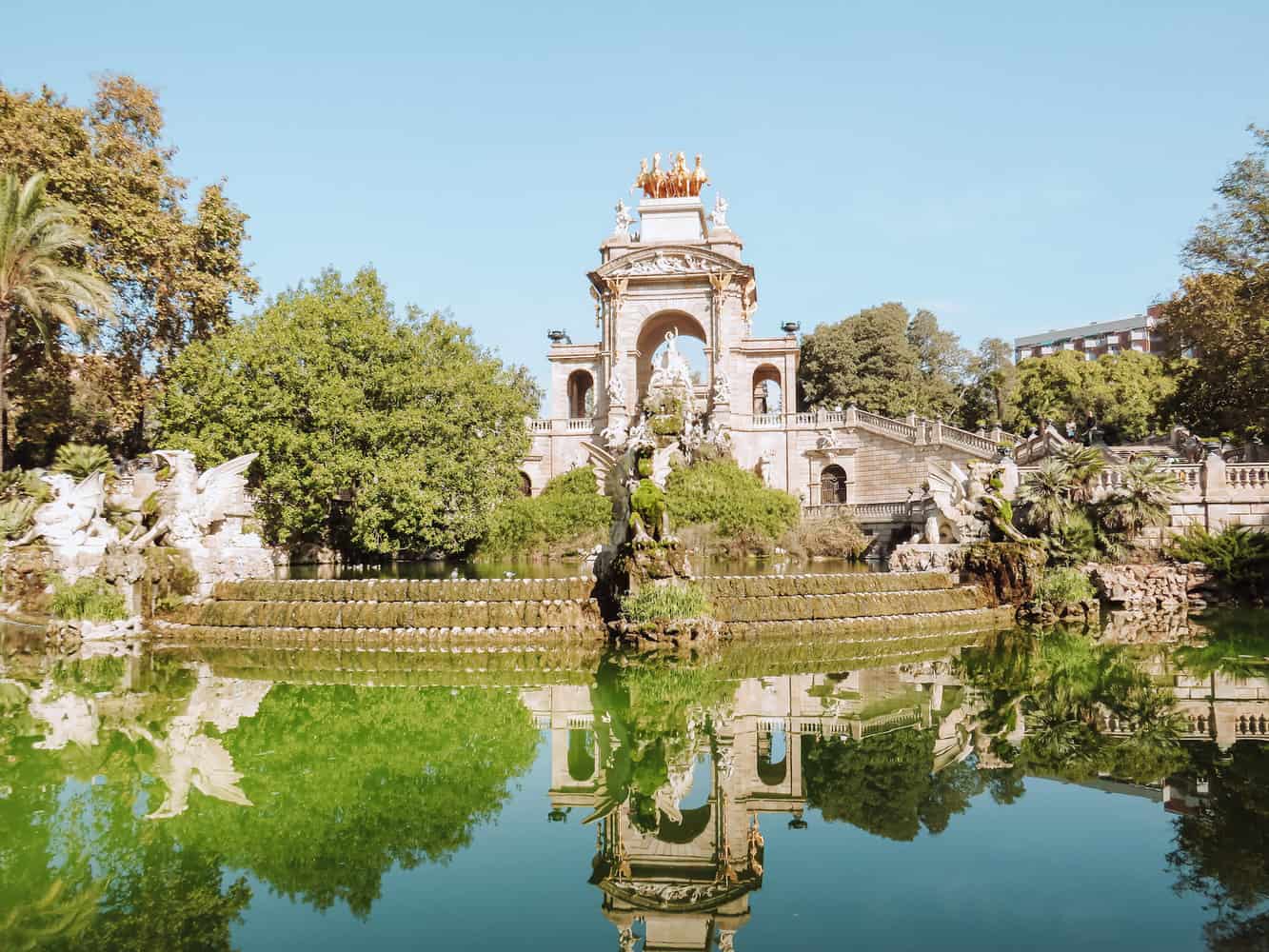Spanish famous landmarks can impress even experienced travellers. One of the most colourful countries in Southern Europe has architectural masterpieces, monuments of ancient civilizations, picturesque mountains, and amazing beaches.
Landmarks in Spain can be found in every corner of the country. So, famous Spanish places are not limited to Barcelona, Madrid or Ibiza.
This post may contain affiliate links, which means I may receive a commission, at no extra cost to you if you make a purchase through a link. Please see my full disclosure for further information.
List of Landmarks in Spain
Spain is a traveller’s paradise, is reach for medieval squares, museums, and natural attractions. One of them is Teide National Park, protected by UNESCO.
In total, there are about 50 objects included in the World Heritage List in Spain. In this article, you will find the bucket list of Spanish landmarks, some of which even make our list of top landmarks in Europe.
- Santiago de Compostela Cathedral, SantiagoGuggenheim Museum, Bilbao
- Museo Nacional del Prado
- Cathedral of Palma de Mallorca
- Ciudad de las Artes y las Ciencias, Valencia
- Royal Palace of Madrid
- Sagrada Familia, Barcelona
- Plaza de Espana,
- Alcazar of Segovia
- Burgos Cathedral
- Alhambra, Granada
- Royal Seat of San Lorenzo El Escorial
- Mosque-Cathedral of Cordoba
- Puente Nuevo, Ronda, Malaga
- Roman Theatre in Merida
- Seville Cathedral
- Casa Mila, Barcelona
- Aqueduct of Segovia
- Plaza Mayor, Madrid
- Muralla de Avila
- El Oso y el Madrono, Puerta del Sol, Madrid
- Alcazar de Toledo
- Gothic Quarter, Barcelona
- Platges de Comte, Ibiza
- Park Guell, Barcelona
- Palau de la Musica Catalana, Barcelona
- Guadalquivir River, Sevilla
- Casa Batllo, Barcelona
- Castillo Colomares Monumento, Malaga
- Tower of Hercules, A Coruna
- Abbey of Monserrat, Barcelona
- Teide National Park, Tenerife, Canary Islands
Landmarks in Spain
Seeing the legendary architecture of Gaudi and the paintings of the famous Spaniard Pablo Picasso is the main goal of all tourists who come to Spain. However, there is much more to see and do in this country.
Major landmarks in Spain are concentrated in Madrid, Barcelona, and Valencia. Learn more about the best landmarks in Spain down below.
#1 Santiago de Compostela Cathedral, Santiago

Santiago de Compostela Cathedral, one of the most famous places in Spain, was built in honour of one of the disciples of Jesus Christ, the Apostle James Zebedee, and today is the most important Catholic shrine for pilgrims from all over the world.
Located in the city of de Santiago de Compostela, it is surrounded by its old part, which is now of historical importance and is included in the list of World Heritage Sites.
It is said that the relics of St. James were found in Galicia in 814. Later, a chapel was built at their location and reconstructed into two stone cathedrals. The current building was founded in 1075, and in 1128 the cathedral was consecrated.
It is one of the Top famous landmarks in Spain, attracting thousands of religious tourists and those who appreciate amazing architecture.
#2 Guggenheim Museum, Bilbao

Guggenheim museum was founded in 1997 in the city Bilbao, de facto capital of Basque country.
The impressive building, one of the famous landmarks in Spain, was created by a well-known architect from America, Frank Gehry, whose work is distinguished by a bold combination of building materials, the originality of forms and the absence of indestructible attachment to the classics.
From a distance, the museum resembles a flower of glass and metal that has blossomed on the riverbank. Guggenheim museum in Bilbao houses major artworks of the 20th century. Although, at temporary exhibitions, you can see works created long before the 20th century.
Drawings of Michelangelo, masterpieces from the St. Petersburg Hermitage, and engravings of Dürer were exhibited here.
#3 Museo Nacional del Prado, Madrid

Looking at the building of the Prado Museum, you admire the grandeur of European architecture, but even more, beauty awaits you inside.
Museo Nacional del Prado is one of the largest museums of fine art in Europe, with a collection of which hundreds of paintings and sculptures of world-famous artists.
From the founding of the museum at the beginning of the 19th century to this day, the museum houses the work of Bosch, Rubens, Goya, Murillo, Dürer, and many other artists, whose names are familiar to even people far from art.
Statues of various periods of particular interest, ranging from antiquity to revival. Some local sculptures were made by order of the Spanish kings, while others went after military campaigns. Additionally, there is a collection of jewellery and treasures of Spanish monarchs, which are stored in the basement of Prado.
#4 Cathedral of Palma de Mallorca

The Cathedral in Palma de Mallorca is considered a real pearl of the Mediterranean, one of the most important landmarks in Spain, which was built for more than 300 years.
The cathedral is visible from afar. You can be truly amazed by its huge sizes. The length of the cathedral is 120 meters, the width is almost 60 meters, and the height is 44 meters.
The cathedral strikes the eye with its splendour and harmony. The Royal Chapel is especially gorgeous, with its altar, stained glass windows, most of which date from the 14th-16th centuries, and the chapel of the Holy Trinity. Also, there is a museum attached to the cathedral, which contains beautiful examples of medieval painting and jewellery art in addition to religious relics. It is better to dedicate the whole day to visiting the cathedral.
#5 Ciudad de las Artes y las Ciencias, Valencia

The City of Arts and Sciences, located in Valencia, is perhaps one of the most extraordinary architectural complexes of our time and one of the best Valencia landmarks.
There are 5 fantastic buildings in Ciudad de las Artes designed for different cultural events. One of them is the Príncipe Felipe Science Museum, an interactive science museum built in the city of arts in the form of a huge whale skeleton, and it looks almost more outlandish than all the others.
It was created by the world-famous architect Santiago Calatrava and built in the channel of the Turia River drained after the 1957 flood.
The total floor area of the three-storey building is 42,000 sq. meters, of which 26,000 are used for exhibitions that will be of interest not only to science lovers but also to ordinary visitors.
Another amazing building is Museo Nacional Centro de Arte Reina Sofia, the opera house of the City of Arts and Sciences Valencia, which is also used for performances in other genres.
#6 Royal Palace of Madrid

The Royal Palace of Madrid is a well-known landmark in Spain and the largest royal palace in Western Europe. For this reason alone, it is worth visiting this beautiful building in the Plaza de Oriente, where the halls of the Throne and the Mirrors stand out.
In Madrid’s Royal Palace, you can see the amazing hall of the Halberdiers and the festive dining hall or the Royal Chapel. In addition, hundreds of rooms are furnished with luxurious furniture from different periods of art history. They even keep an extraordinary collection of Stradivarius violins.
Make sure you read our one week in Spain itinerary that includes a visit to the Royal Palace.
#7 Sagrada Familia, Barcelona

La Sagrada Familia, one of the most famous monuments in Barcelona, still unfinished in construction, is a masterpiece of the modernist genius Antonio Gaudí. Sagrada Familia attracts thousands of tourists every year who contemplate the facades of the Nativity, Passion and Glory and its flamboyant interior decoration.
Inside the basilica La Sagrada Familia is also a museum dedicated to the Catalan architect, displaying the various models, plans and other items that Gaudí used to create one of his masterpieces.
Starting in 1882, the Sagrada Familia has become one of the world’s most famous long-term construction projects and the main landmark of Spain. It is planned to complete the construction of the temple in 2026, on the 100th anniversary of the death of Gaudí.
#8 Plaza de Espana, Madrid

Famous landmarks in Madrid include Plaza de España, the most important square in the Spanish capital. To the north of the square is Martin de Los Eros, a beautiful street at any time of the day and boasts two of the best cinemas in Madrid.
Behind it is a quarter with multiple shops, bars, and a VIP zone that works around the clock – Centro Princesa. The area, like all the architecture of Madrid, is very interesting.
In Plaza de Espana there is something to see for tourists from all over the world, so don’t miss it, especially when you are travelling to Spain with Kids!
#9 Alcazar of Segovia, Segovia
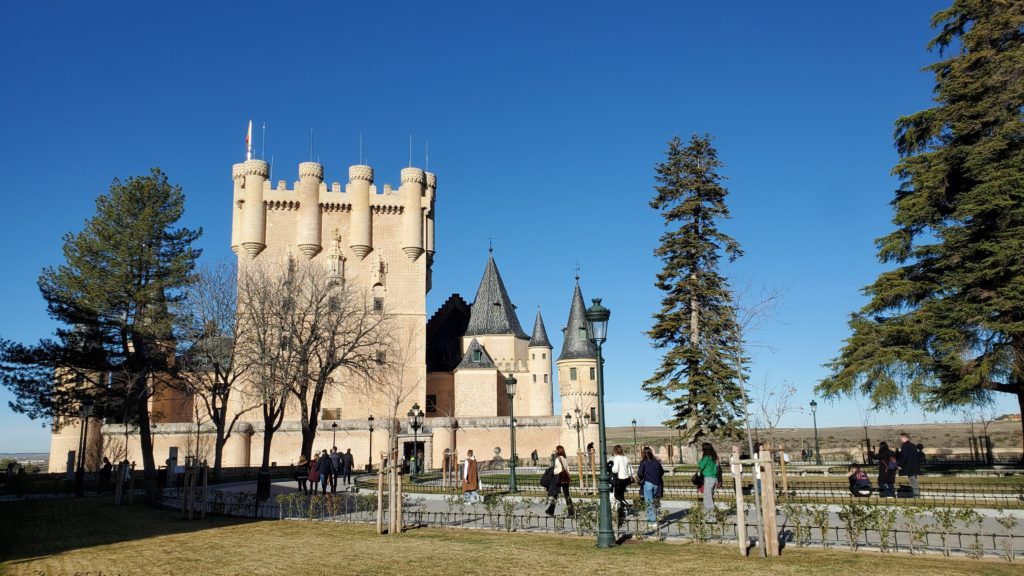
One of the most famous Spanish landmarks, the Alcazar de Segovia, dates back to the 9th century, but the first mention of it appeared only in 1120, so one can only guess how the fortress looked before. Then the king of Castile, Alfonso VIII, wished to turn the Alcazar into his residence, so he gave the order to start building the stone castle that we see today.
Later, the fortress Alcazar of Segovia became a favourite place of the Spanish monarchs, where more than one coronation, wedding and signing of important treaties would take place.
Like any fortress, the Alcazar managed to be both a prison and a military institution, and finally, it turned into a museum. There are several halls with various expositions inside, where you can get to know the history and culture of that era.
The Alcázar de Segovia has long been one of the most popular attractions in Spain.
#10 Burgos Cathedral, Burgos

Burgos Cathedral is a classic example of Spanish Gothic. An architectural masterpiece in the centre of the Old Town, with a lace facade and rich interior decoration, attracts many curious tourists.
The construction of the famous landmark in Spain began in the 13th century and was completed only by the middle of the 16th century. The interiors are decorated with unique stone carvings, sculptures, gilding and other valuable materials. A monument to the pilgrim is built on the palace square, next to which there are two beautiful fountains.
#11 Alhambra, Granada

Year after year, the beautiful Alhambra Palace in Granada leads the list of the most visited monuments in Spain because this ancient palace-fortress of the Nasrids has no analogues in Europe. No other country on the Old Continent can boast of building this style.
The Alhambra in Granada, a masterpiece of Andalusian architecture, brings together a large group of residential complexes called Nasrid palaces, among which the palaces of Comares and Los Leones stand out, where their famous fountain is located. It is also worth visiting its defensive part, where the Alcazaba is located. And, of course, the magnificent gardens of the Generalife.
#12 Royal Seat of San Lorenzo de El Escorial, San Lorenzo El Escorial

The Royal Monastery of San Lorenzo de El Escorial is one of the greatest monuments not only of the Community of Madrid but of all of Spain, as it is also considered the world’s eighth wonder.
The royal complex the building was built in the 1500s and is one of the best-preserved landmarks in Spain.
Felipe II ordered its construction to commemorate the Battle of San Quintin. Since then, successive monarchs of the Houses of Habsburg and Bourbon, who rest in the Royal Pantheon, carried out various reforms in this magnificent monumental complex.
#13 Mosque-Cathedral of Cordoba

Mosque-Cathedral was built in Cordoba in 784. During the Middle Ages, it was the second-largest Muslim Mosque in the world, and now it is considered the most famous architectural structure in Spain, built during the reign of the Umayyad dynasty. Now, the building is in the TOP-4 of the largest mosques in Europe.
The interior decoration of one of the best historical locations in Spain is striking in its beauty and richness:
- Golden prayer niches
- High double arches of black onyx and jasper inside the mosque
- A majestic blue dome with pale stars in the centre of the Mesquite
#14 Puente Nuevo, Ronda, Malaga

This 18th-century bridge, which rests on the bottom of the El Tajo Gorge, located at a depth of 120 meters, is one of the most iconic sights in Ronda and all of Spain.
Construction of the Puente Nuevo, intended to replace a previous bridge that had collapsed a few years earlier, began in 1759. The construction of the new bridge took 42 years and cost the lives of about fifty workers.
Used as a prison for centuries, the room above the main arch now houses a small exhibition about the bridge and its construction.
#15 Roman Theatre in Merida, Merida, Badajoz

In the small town of Merida, a reminder of the events of past years remains, namely the Roman theatre, dating back to 15-16 years. BC e.
The theatre reached its heyday around the 3rd-4th century, but with the decline of antiquity, it was gradually forgotten, and centuries later, it was almost completely buried underground.
150 years ago, only the upper rows of seats, called “Seven Chairs”, were visible on the theatre site. According to legend, it was on them that the local rulers sat, deciding the fate of Merida.
At the beginning of the last century, excavations began, and by 1960 restoration work was actively underway. Now the theatre is not only the city’s main attraction but also the venue for one of the oldest theatre festivals in Spain.
You May Also Like: Best Water Parks in Spain
#16 Seville Cathedral, Sevilla
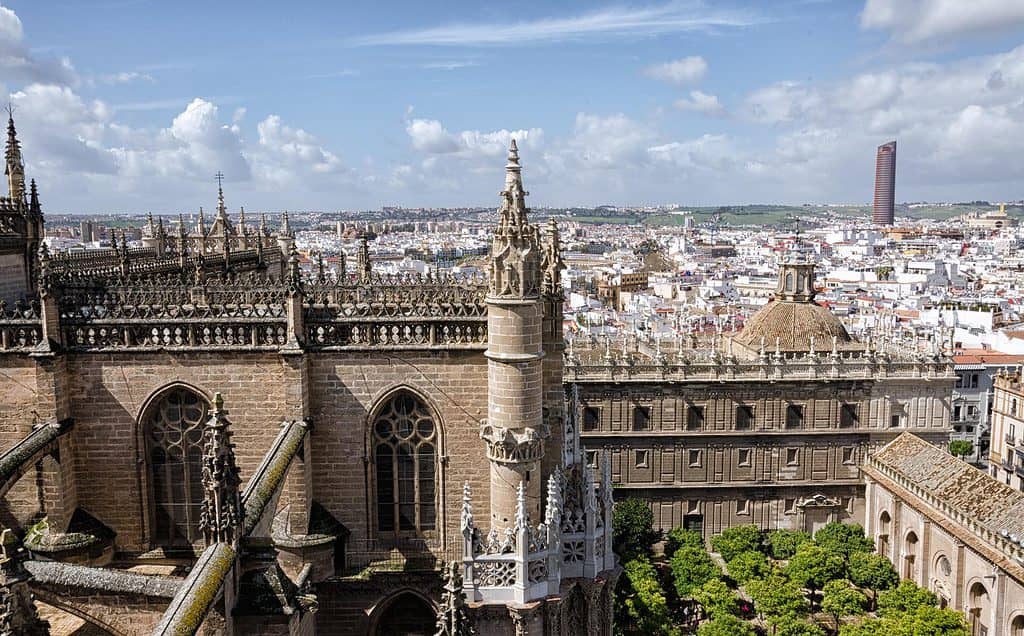
Seville is one of the best cities in Spain to visit. When tourists with children think about what to do in Seville, they usually look for amusement parks or other children’s entertainment. But there is one adult attraction in the capital of Andalusia that should be shown to children as well – this is a must-visit place.
Seville Cathedral is the largest Gothic cathedral in Europe, listed as a UNESCO World Heritage Site. The temple is also the burial place of Christopher Columbus. But even if you do not know about it, the building will amaze you with its majesty and harmonious fusion of different architectural styles.
#17 Casa Mila, Barcelona

Casa Mila is one of the most visited attractions of the capital of Catalonia, annually hosting about a million guests from all over the world. The bizarrely shaped building is the work of the legendary architect Antoni Gaudí, so it’s no surprise that it’s noticeable from afar.
A fabulous, almost alien construction attracts little and adult travellers like a magnet. The undulating facades of golden colour are more like Poseidon’s underwater castle than an earthly structure. The pearl of the urban ensemble looks especially fantastic at night when the backlight turns on.
Arriving in Barcelona, you can not only look at the amazing building of Casa Milà but also get inside to see in detail the interiors and layout, which were created with such love by one of the most brilliant masters of world architecture.
#18 Aqueduct of Segovia

The Roman Aqueduct, or building in the form of a bridge for supplying water, is located in Segovia. It is the most popular monument preserved in Western Europe since the Roman era.
The exact date of construction is unknown, but scientists suggest that the structure appeared in the 1st century AD. The length of the structure is 728 m, the height is 28 m, and the number of arches is 167. Being part of a multi-kilometre water pipeline until 1884, it was used for its intended purpose. Through it, water was supplied to city services from the Frio River, which flows below.
The Aqueduct of Segovia is impressive and mesmerizing at the same time. This unique engineering structure has a high status and is rightfully included in the UNESCO list.
#19 Plaza Mayor, Madrid

Plaza de Mayor is one of the main squares of Madrid, and the Spanish playwright Lope de Vega proudly called it “the navel of Spain”. Indeed, since its founding in the 17th century, Plaza de la Mayor has become a place where there have always been many citizens.
The first specially equipped bullfighting ground played a large role in this in Spain then: Bullfights were held in improvised arenas for a long time. Now they don’t arrange bullfighting on the Plaza Mayor. Still, there is a spectacle no less impressive, the Casa de la Panaderia, a building where the royal family sat on the balcony centuries ago. At that time, a bakery worked below.
#20 Muralla de Avila
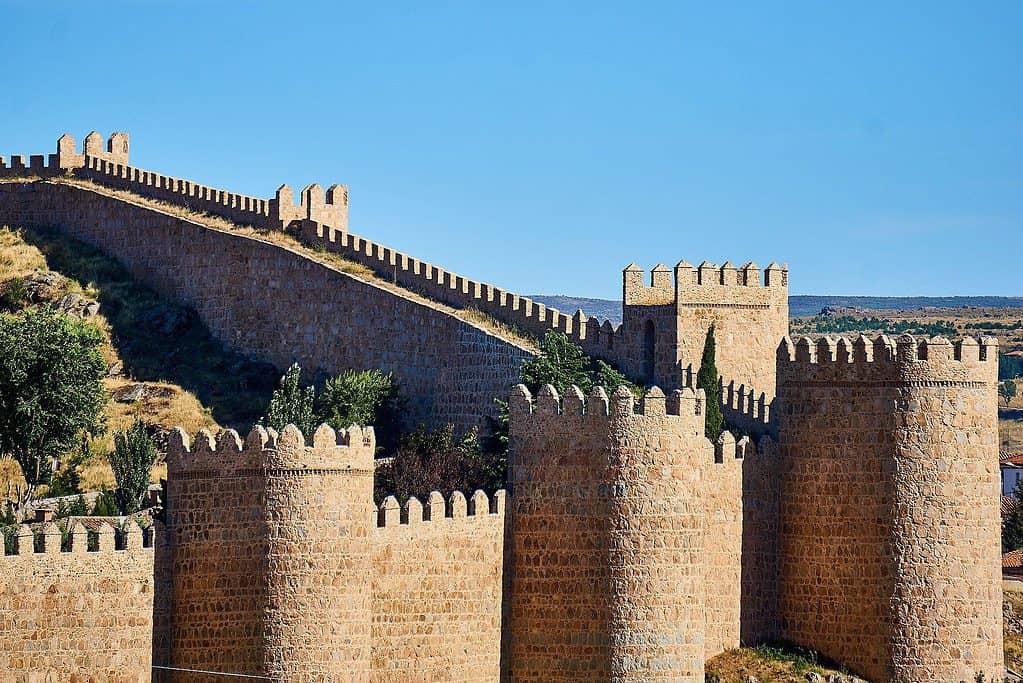
The powerful fortifications in the old town of Avila have stood motionless for more than 900 years, from the 12th century. Not only residents but also eminent Moorish architects were involved in the construction.
The walls of Ávila are second in size only to the Great Wall of China. The fortress stands on the ruins of ancient fortifications built during the Roman Empire. Some of them were used as a building material, so you can still see stones in the walls that differ in colour and texture. The work took 9 years, resulting in a high 12-meter wall stretching for 2.5 km.
#21 El Oso y el Madrono, Puerta del Sol, Madrid
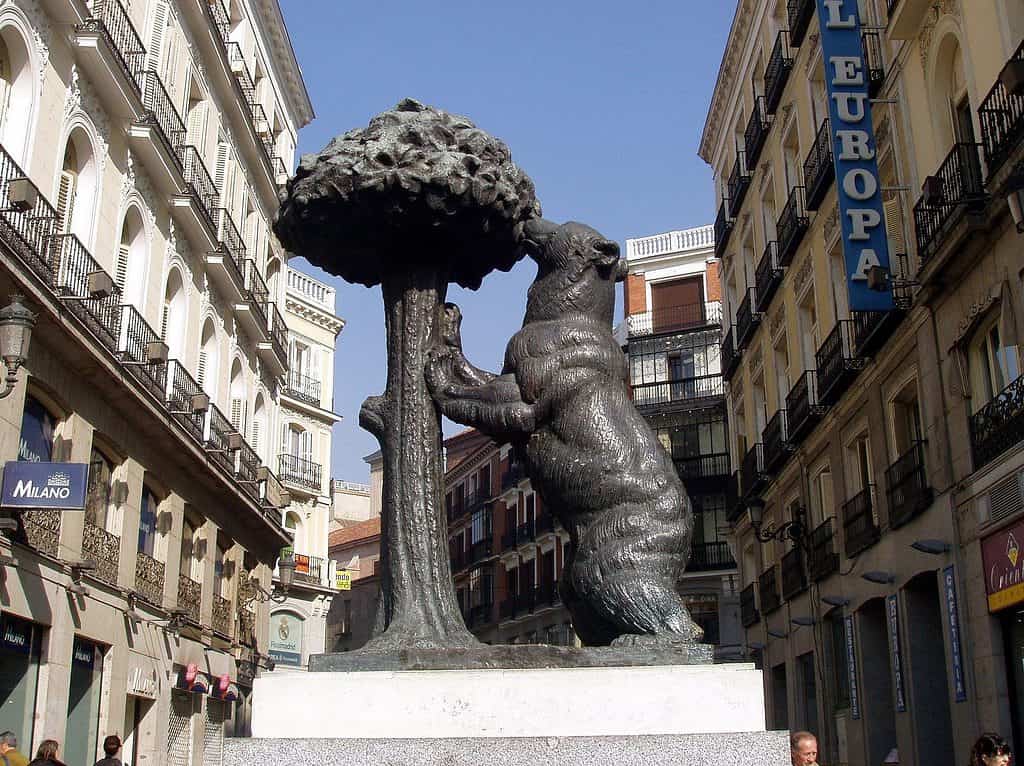
One of the most famous monuments in Madrid is a bronze sculpture of a bear with the strawberry tree, the main symbol of Madrid. The image of a bear on its hind legs, which eats berries from tree branches, is even present on the city’s coat of arms.
Even though this symbol is quite ancient, and there is no consensus about its origin, the sculpture appeared relatively recently – in 1967. It is in the city centre, on Puerta del Sol. The height of the composition is 4 meters, and the weight is about 20 tons. There is a belief that you can make a wish by touching a bear, and it will surely come true.
#22 Alcazar de Toledo
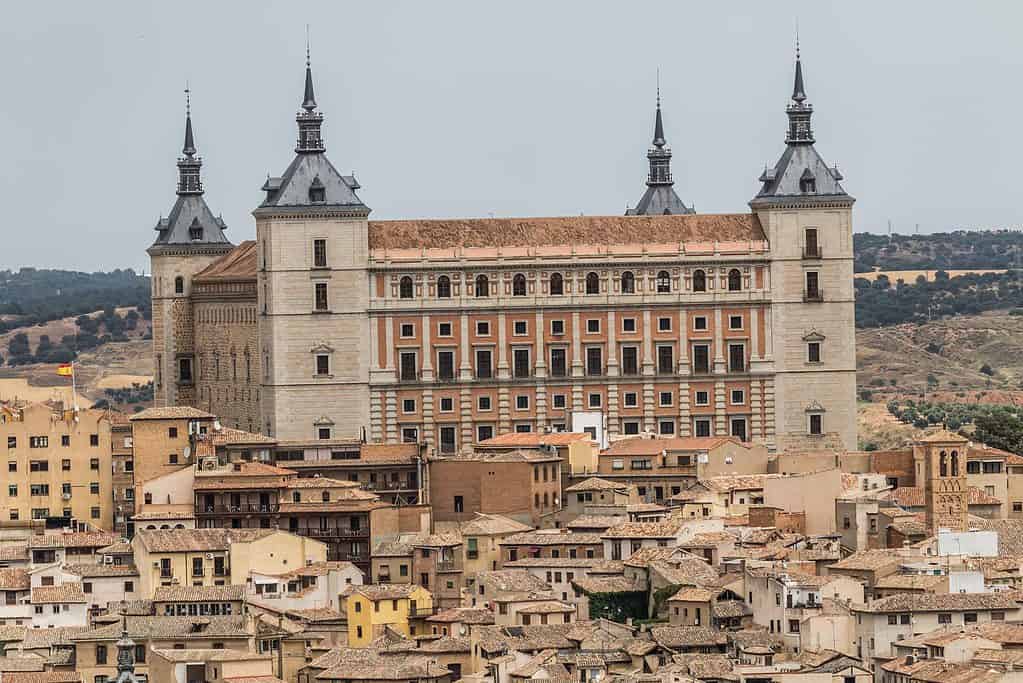
In the upper part of the city of Toledo, the Alcazar stands from the 16th century, illuminated in the evenings by dozens of lights. Conquered from the Moors, the Spaniards significantly rebuilt it after long battles. For some time, the Alcazar became a peaceful territory, and a truly royal decoration appeared inside because the fortress became the residence of Pedro I, the King of Castile.
Spaniards of the older generation remember the events of 1936 when Alcazar was besieged by state troops for two months during the civil war, trying to drive out the rebels.
The fighting severely damaged the fortress and claimed many human lives. Restoration began only after the end of the Second World War, and now the fortress pleases the eye even of people who are indifferent to ancient architecture. Inside are the State Library and the Army Museum.
#23 Gothic Quarter, Barcelona

The Gothic Quarter of Barcelona attracts a lot of tourists. Medieval buildings have retained the spirit of antiquity and harmoniously coexist with more modern buildings.
Many temples on the streets are historical and architectural monuments; the most famous is the cathedral.
In the intricacies of the gothic style quarter, you can always find a quiet place, relax, and have a bite at the table of a small cafe. This place is among the best Barcelona landmarks.
#24 Platges de Comte, Ibiza

Ibiza is one of the most famous and popular Balearian islands. The size of this picturesque island is relatively small, but Ibiza landmarks have a lot to offer. One of the best landmarks on Ibiza are the beaches Platges de Comte.
You will find as many as three bays with small, fabulously clean water on this low-end cape. Beaches with snow-white sand are turned to the west, making this place incredibly popular for sunset watching. In the afternoon, hundreds of people gather here who want to admire how the sun falls into the waters of the Mediterranean Sea.
#25 Park Guell, Barcelona

In 1901, the Catalan industrialist Eusebi Güell, inspired by the example of the British, wanted to build a garden city in Barcelona.
According to his plan, Guell would become a paradise on earth, combining the best of the village and the city. However, the remoteness from the centre and the lack of the necessary infrastructure scared away the Barcelona residents, and out of 62 plots for the construction of houses, only two were sold. The situation was saved by the architect Antonio Gaudi, who created the Park Güell as we see it now. Park Guell is one of the world’s famous parks.
In Barcelona, Gaudi landmarks also include the Gaudi House Museum, the “Hall of a Hundred Columns”, the main staircase with fountains and, of course, the famous Gaudi bench, curved in the shape of a snake.
Get Your Park Guell Tickets Here Before They Sell Out!
#26 Palau de la Musica Catalana, Barcelona

The Palace of Catalan Music is one of the famous Spanish landmarks, located in the historic district of Barcelona, in the Born quarter.
This architectural monument is under the protection of UNESCO. The architecture of the building includes everything characteristic of Catalan Art Nouveau. Instead of straight lines – curved lines, a huge number of artistic ornaments, dynamic forms – all this is an integral part of the palace architecture style.
The Palace of Catalan Music in Barcelona is the only building in all of Europe that is lit only by natural light during the day.
Not only is it excellent in its beauty with stained glass windows, but it is also curved inwards with a dome. The ceiling is a huge dome representing the sun and sky. It consists of coloured stained glass mosaics; in the centre of the dome are golden hues, and a mosaic of blue hues around it.
#27 Guadalquivir River, Sevilla

The Guadalquivir River is one of the most famous Spanish rivers, the waterway of the city of Seville. The Guadalquivir descends from the northern part of the Andalusian Mountains and, at the end of the path, flows into the gulf of Cadiz in the Cadiz province. It is the fifth longest river in Spain – 657 km.
Residents use the reservoir to irrigate fields, generate electricity and travel on small boats.
To get to know Seville better, tourists like to take river tram rides along the river’s calm waters, admiring the local attractions and picturesque views of the surroundings.
#28 Casa Batllo, Barcelona

Casa Batlló is a UNESCO Heritage site, one of Spain’s most iconic landmarks. The Batlló house was designed by Antonio Gaudí and is one of the most famous buildings in Spain.
Antonio Gaudí worked on the building from 1904 to 1906. Initially, the house’s owner, textile magnate Josep Batllo y Casanovas, wanted to demolish the building and build a new tenement house, for which he provided the building at the complete disposal of Gaudí. However, the architect changed his mind about demolishing the building and completed its reconstruction.
One of the best buildings in Spain impresses with the thoughtfulness of the smallest details, but it is also very functional. Researchers believe that the work on the Batlló house, one of the most famous Spanish buildings, was the beginning of a new stage in Gaudi’s work.
You May Also Like: Malaga to Barcelona
#29 Castillo Colomares Monumento, Malaga

This is a unique castle-style monument built in honour of Christopher Columbus. The construction of the Colomares Castle in Benalmadena began in 1987, lasted for seven years and ended just in time for the 500th anniversary of the discovery of America. Today it is the largest monument to Columbus, not only in Spain but throughout the world.
For several years after the official opening, Castillo De Colomares was used exclusively for falconry. True, when the cats of residents began to disappear due to birds of prey, this entertainment had to be abandoned. For some time, the castle remained closed and then slowly but surely began to turn into one of the most visited places in Benalmadena. This one of the most famous monuments in Spain is a must-visit place.
Read More About Travelling to Malaga with Kids Here >>>
#30 Tower of Hercules, A Coruna

Located on the northern peninsula in A Coruña, the Tower of Hercules is the only lighthouse of Roman origin still operating today.
A stone watchtower from the 1st century AD, there is also an observation deck from which you can enjoy a beautiful view of the Atlantic Ocean.
The Tower of Hercules, guiding ships since the 1st century AD, one of the most important monuments of Spain, is also in a beautiful location and home to the Rose of the Winds and the Breogán sculpture.
#31 Abbey of Monserrat, Barcelona

Montserrat Monastery is the spiritual symbol of Catalonia and a well-known pilgrimage centre in Spain as well as one of the most famous landmarks in Spain.
The holy place is located at the foot of the mountains of Montserrat, which means “Cut Mountains”, from which it took its name. The temple is located at an altitude of 725 meters above sea level.
Barcelona is located 50 kilometres away. A 10 km long mountain range made of limestone rocks attracts the attention of many tourists who come to Spain. Recently, the territory has been considered a national park of Catalonia.
#32 Teide National Park, Tenerife, Canary Islands

On the island of Tenerife, known for its volcanic activity, Teide National Park was created in 1954. The desert landscape gives the impression of a plight of flora and fauna on the island, but this is far from the case.
The island would be perfect for filming a western or a movie about a trip to a distant, uninhabited planet. And yet, Teide is quite inhabited, so be sure to add the park to your itinerary – impressions and beautiful photos are guaranteed.
One of the best sights in Spain, Teide National Park, 2007 has been on the UNESCO World Heritage List.
Discover More of Spain
-
One Week in Spain Itinerary for Families – Barcelona, Madrid, Seville and Malaga
(Last Updated On: ) Looking for an amazing one week in Spain itinerary? Spain is a fantastic country to visit with kids. Not only can you find historical and cultural activities for adults, but child-friendly attractions too. If you only have seven days in Spain, we have come up with the perfect itinerary for you.…
-
18 AMAZING Things to Do in Alicante with Kids + 2024 City Break Guide
(Last Updated On: ) Thinking of visiting Alicante with kids? Located on Spain’s sun-drenched Costa Blanca, Alicante is bursting with life, culture, and activities perfect for families. The city offers an exciting blend of history and beaches. I visited Alicante for 4 nights before our Mediterranean cruise this summer. Me and my 4-year-old daughter had…
You May Also Like
Sylvie Simpson is the founder of European Cities with Kids. For the past 6 years, she has been travelling all over Europe whenever she has the chance, both solo, for work and with her daughter. Sylvie is on a mission to help people make the most of city breaks in Europe with kids and helps over 50,000 readers per month plan and make the most of their trips in Europe with kids.

